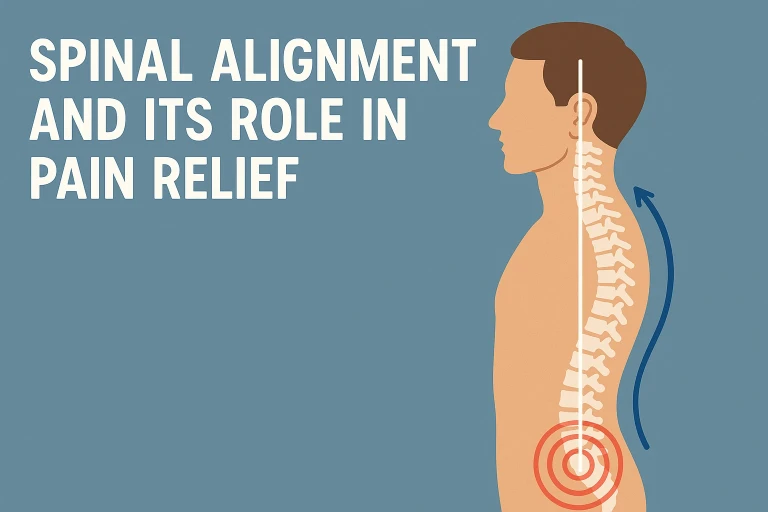
In everyday life, spinal alignment is one of those things most people rarely think about, until something hurts. Yet the spine is the structural and neurological center of the body.
When it shifts out of balance, even slightly, the nervous system reacts, muscles compensate, and pain begins to surface in ways that can feel unrelated. For patients searching for reliable, local, focused information about pain relief options in their area, understanding spinal alignment is essential.
Why Spinal Alignment Matters
The spine protects the spinal cord, supports body weight, and coordinates movement through a network of vertebrae, discs, ligaments, and joints. When aligned correctly, the spine distributes mechanical stress evenly, allowing the body to move efficiently without strain.
When misaligned, the body begins compensating. Muscles tighten, joints lose their natural motion, nerves become irritated, and pressure builds in areas not designed to carry that load. The result is a range of symptoms that often include:
- Back or neck pain
- Radiating arm or leg discomfort
- Headaches or facial tension
- Reduced mobility
- Stiffness after sitting or waking
Spinal alignment isn’t just structural, it directly affects how the nervous system handles signals throughout the body. Even small shifts can disrupt communication, leading to persistent and sometimes unexplained pain.
How Misalignment Happens
Spinal misalignment can develop slowly over years or appear suddenly after an injury. Common causes include:
- Poor posture from phones, computers, or workstations
- Repetitive movements at work
- Falls or minor accidents
- Stress and muscle tension
- Sleeping positions that strain the neck or lower back
- Sports or physical exertion
Over time, these stresses change the way joints move. If uncorrected, the problem becomes chronic, often leading patients to search for long-term solutions rather than temporary pain relief.
The Connection Between Alignment and Pain Relief
Pain is often the body’s signal that alignment has shifted. But spinal misalignment doesn’t always cause pain at the site of the problem. For example:
- Neck misalignment can trigger headaches or shoulder pain.
- Mid-back imbalance can affect breathing or rib mobility.
- Lower spine issues can create hip, knee, or even foot discomfort.
Because the spine distributes weight and motion throughout the entire body, one area out of balance forces another to overwork. Correcting the alignment allows overworked muscles to relax, irritated nerves to settle, and joints to regain their natural motion.
How Chiropractic Care Addresses Alignment
Chiropractors evaluate the spine as a whole, not just the area where pain appears. Using targeted adjustments, they restore natural position and movement to spinal joints that have become restricted or misaligned.
When the spine moves properly again, several things happen:
- Nerve irritation decreases
- Muscles loosen and strengthen naturally
- Inflammation reduces
- Mobility improves
- Pain decreases without medication
This approach focuses on restoring function rather than masking symptoms. Patients benefit from long-term improvement because the root of the problem is corrected.
Why Alignment Matters for Chronic Conditions
Many chronic pain conditions are directly tied to alignment issues, including:
- Sciatica
- Chronic lower back pain
- Neck pain from posture
- Tension headaches
- Degenerative joint changes
- Shoulder and hip imbalance
Restoring alignment often reduces the frequency and intensity of flare-ups, allowing the body to maintain stability over time. When paired with strengthening, stretching, and lifestyle adjustments, spinal alignment becomes a foundation for long-term wellness.
Spinal Alignment and Modern Lifestyle Challenges
Today’s lifestyle places more strain on the spine than ever before. Long hours at desks, handheld devices, and sedentary routines create a constant forward-head posture that disrupts cervical alignment. Remote work setups can strain the lower back and pelvis. Even driving habits contribute to spinal tension.
What Patients Can Expect During an Alignment Evaluation
A chiropractic spinal alignment evaluation typically includes:
- Postural assessment
- Range of motion testing
- Palpation of restricted joints
- Neurological and orthopedic screenings
- Imaging when necessary
This comprehensive approach identifies exactly where misalignment occurs and how it affects the rest of the body.
Benefits of Maintaining Proper Spinal Alignment
Patients often notice far more than pain relief. Common improvements include:
- Better mobility and flexibility
- mproved posture
- Reduced muscle tension
- Better sleep
- Increased physical performance
- Decreased fatigue
- Lower stress levels
Because alignment influences the entire musculoskeletal system, the benefits extend well beyond the spine.
Spinal alignment plays a fundamental role in how the body moves, feels, and functions. When alignment is correct, the nervous system communicates clearly, joints glide the way they’re designed to, and the body distributes pressure evenly. When misalignment develops, pain and dysfunction follow.
Understanding spinal alignment, and correcting it through chiropractic care, is one of the most reliable, natural ways to relieve pain without medication or invasive procedures.
As more people search for solutions in their own communities, optimized content helps connect them with the care they need and the long-term relief they’re looking for.
Visit Campbell Chiropractic in Wasco, CA
Dr. Dennis Campbell and his team at Campbell Chiropractic, 620 E St, Wasco, CA 93280, are dedicated to helping patients restore balance, comfort, and confidence.
Call (661) 758-5131 or visit today to schedule a consultation and discover why so many people in Wasco and Kern County trust Campbell Chiropractic.







Leave a comment